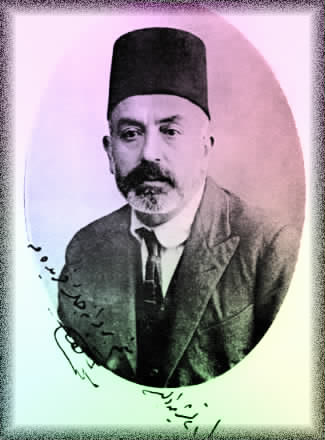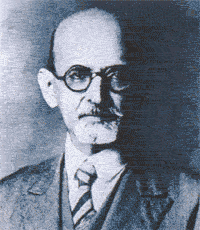<Back to Index>
- Composer and Conductor Edgar Manas, 1875
PAGE SPONSOR


Edgar Manas (Armenian: Էտկար Մանաս April 12, 1875 - March 9, 1964) was an Armenian composer, conductor and educator.
Edgar's father, Alexandre Manas, was the chief translator for the Ottoman Public Debt Administration. The family lineage may be traced back to Caesarea [now Kayseri], where it originated in the mid sixteenth century. Raphael Manas (c.1710 - 1790), an official painter of the Ottoman Sultanate, was arguably the most outstanding figure of the Manas dynasty: he made the portraits of Mahmud I, Osman III and Mustafa III.
Edgar Manas was born on April 12, 1875 in Constantinople [now Istanbul]. Artistically gifted young Edgar was sent to Italy at the age of 13 to attend the Murat - Raphaelian Armenian School to study commerce. While in Venice he also took piano lessons with Professor Trivellini. Upon graduating in 1894, he returned to his native city. Yet, his impulse to continue his music studies took him back to Italy, where he settled in Padua and worked with composer Luigi Bottazzo, focusing on harmony, counterpoint and fugue.
Back in Constantinople, Manas pursued his music studies further. He concentrated primarily on composition by examining the classics and the works of contemporary French masters. He produced a series of piano composition in the idiom of Chopin, including “Minuet - Valse” which was published in 1905 by A. Comendinger of Constantinople. During the same year, Edgar Manas conducted the Gallia choral group in a concert at Salle de fêtes de l'Union française, a local auditorium, which earned him the order of Officier d’académie from the French government.
In 1912, Manas made the acquaintance of Komitas, the founder of modern Armenian music. Although their relationship was cordial, it was not particularly close, for Manas and Komitas lived in two different aesthetic worlds.
The same year, Leipzig based Breitkopf & Härtel published two of Edgar Manas’s compositions – Suite for piano and String Quartet. It was followed by other European publishing houses, including Salabert, Senard and Hamelle. Manas’s music was performed often in Istanbul, and, on occasion, in European music capitals.
The Suite for Piano and String Quartet, mentioned above, was premiered in an all Manas program on May 6, 1921 at Union française. Members of the quartet were violinists Ekrem Zeki Ün and Krikor Garabedian, violist Diran Israelian and cellist Kalayov. On this occasion, the composer performed his Piano Suite and accompanied soprano A. Khandjian in a number of songs. A few years later, the Suite was performed in Leipzig with much success. Martin Friedland wrote the following in Neue Zeitschrift für Musik:
Dieses Quartett … entstammt klassizistisch-neuromantischer Gefühls- und Gedankensphäre. Es beginnt mit einer Fughetta, die sich auf rhythmisch-charaktervollem Thema aufbaut, und läßt ein prägnantes, gedrungenes Stakkatoscherzo mit einem kantablen Lento an Trio-stelle folgen. Ein kurzes, “Lied” benanntes, große melodische Bögen spannendes Adagio folgt als dritter Satz, und ein schwung- und temperamentvoll dahin-strömendes “Finale”, voll inneren Lebens, beschließt das knapp gehaltene Werk. Ohne harmonisch oder formell Neuland zu suchen, zeigt es die Hand eines mit der Eigenart des Quartettstiles wohlvertrauten Musikers, der vortreffliche thematische Arbeit leistet und an ehrlichem, jeglicher Affektation abholdem Bilden und Gestalten Genüge findet. Ein ebenso hörens- wie spielenswertes Stück.
(This Quartet… derives from a Classic / neo-Romantic sensibility and conception. It begins with a Fughetta that is based upon a theme of rhythmic character and followed by a succinct, sturdy, staccato Scherzo with a cantabile Lento as Trio. A short Adagio spanned by long melodic arcs, titled “Lied,” follows as the third movement; and a lively, vivacious, flowing Finale, full of inner life, brings this concise work to a close. Without exploring new harmonic or formal territory, it shows the hand of someone with the characteristic quartet style of familiar masters, who achieves excellent motivic work and finds pleasure in honest images and forms averse to any affectation. A piece as worthy of hearing as it is of playing.)
Manas was soon appointed to the directorship of the Քնար (Lyre) chorus, associated with Armenian Youth League of Constantinople. Between the years 1920 – 22, he became affiliated with the Արուեստասէր (Devotee of the Arts) music organization, conducting their annual presentations. During the final concert on January 20, 1922, the program included Manas's own composition, «Իմ մահը» (My Death), in addition to works from the standard repertoire.
Manas was engaged to teach music at the Esayan Armenian day school and was hired by Dârülelhan (the precursor of the Istanbul State Conservatory) in 1923 to conduct the orchestra and establish the first women’s choir in the newly founded Turkish Republic. Manas also taught harmony at the Bahariye Mektep Bandosu and Orkestrası (Bahariye School Band and Orchestra). The vocal - symphonic ensemble of the conservatory presented its first concert at the historic Galatasaray High School on March 28, 1924. The program included excerpts from Saint - Saëns’s Samson et Dalila, Meyerbeer’s L'Africaine, Schumann’s Nänie, as well as purely orchestral works by Gluck, Schmitt, Schumann and Mendelssohn.
In 1923, Hamelle published a collection of songs by Manas, which were based on Armenian poetry but were presented in their French translation by Yetvart Kolandjian. In 1924, it was followed by the publication of his Sonata for violin and piano, premiered to critical acclaim on December 19, 1932 at the main auditorium of the Paris Conservatoire. Kevork Sinanian was the violinist and the composer was at the piano.
In February 1926, Salabert of Paris printed Manas’s piano work, Les îles des princes (Princes' Islands). The composition consisted of four movements, each portraying one of the main islands of the archipelago in the Sea of Marmara. Manas soon made an orchestral version of the work.
Edgar Manas perhaps is best remembered for his work on İstiklal Marşı, the Turkish National Anthem. In 1932, he was commissioned by the Turkish Republic to harmonize and orchestrate the melody created by Zeki Üngör. In 1933, a choir of 160 members performed his Vatan Şarkısı (National Song) at the Tepebaşı Tiyatrosu in Istanbul. The following year, Manas arranged and published 5 Türk Halk Şarkısı (Five Turkish Folk Songs) and, in 1935, composed Danses populaires Turques (Turkish Folk Dances) for piano, published by Editions Maurice Senard in Paris.
Manas was appointed choirmaster of Գողթան երգչախումբ (The Choir of Goghtn) of the Armenian patriarchal church in Istanbul, where he served for twenty years until 1957. His Rapsodie de l'orient was performed by Istanbul Municipal Orchestra under the baton of Cemal Reşit Rey in 1959.
Edgar Manas has composed a sizable body of sacred music. The most significant among them is perhaps the Armenian Divine Liturgy for soloists, choir and organ. It was initially conceived in 1912, but was given its final form in 1948. The large scale composition was premiered in Istanbul in 1961 and published in Vienna in 1962. In the forward of the printed score, the composer writes:
Compared to the Latin Mass, which consists of five movements of various lengths, the Armenian Divine Liturgy is made of several short segments that are interconnected. In order to avoid any kind of monotony and to conclude the work with a proper ending, I decided to augment certain numbers…and finish the composition with a chorale and fugue. This particular Divine Liturgy with organ obbligato, reserved for special occasions, requires a big chorus in order to project the necessary volume in loud portions, and create an even and opaque sonority in soft passages.
Edgar Manas was a sophisticated composer, who was at home in various musical styles and convincing in writing works of art in different idioms. For example, his Sonata for violin and piano exhibits a Germanic complexity of texture, while the Divine Liturgy is essentially Gallic in spirit. His music is fervid yet controlled, perfectly crafted if generic.
His students included members of the Ottoman Palace, Turkish musicians, such as Hüseyin Sadeddin Arel and Dr. Suphi Ezgi, and Armenian composers, including Ara Bartevian and Koharik Gazarossian. Edgar Manas is buried in the Armenian Catholic cemetery of Şişli, Istanbul.
A large portion of Manas’s manuscripts are archived at the Charents Museum of Literature and Arts of Armenia.